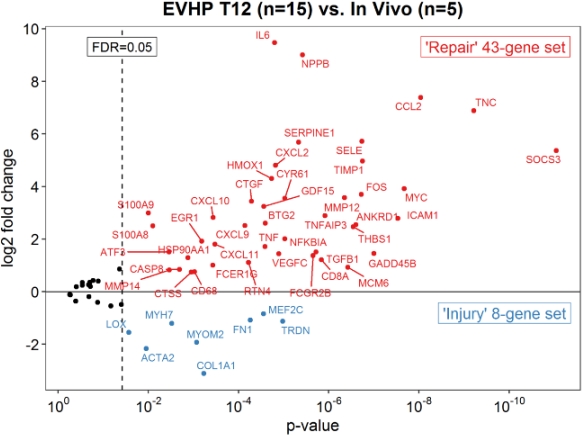Molecular Injury and Repair Assessment in Ex Vivo Perfused Swine Heart Transplants
University of Alberta, Edmonton, Canada.
Meeting: 2018 American Transplant Congress
Abstract number: D63
Keywords: Gene expression, Heart preservation, Machine preservation, Pig
Session Information
Session Name: Poster Session D: Ischemia Reperfusion Injury: Time to Change the Fate?
Session Type: Poster Session
Date: Tuesday, June 5, 2018
Session Time: 6:00pm-7:00pm
 Presentation Time: 6:00pm-7:00pm
Presentation Time: 6:00pm-7:00pm
Location: Hall 4EF
Background: Cardiac transplantation is a life-saving intervention for advanced heart failure but it is unfortunately limited by a critical shortage of suitable donor organs and low rates of utilization. Ex vivo heart perfusion (EVHP) is a promising alternative for organ preservation and repair that may increase the number of hearts available for transplantation. However, the mechanisms of EVHP remain poorly understood and our ability to assess donor organ quality is suboptimal. The goal of this study is to assess the utility of molecular analysis for quantifying cardiac injury and repair in a large animal model for EVHP.
Methods: Heart samples were obtained from 24 pigs either in vivo (IV, n=5) or after 12 hours of EVHP (n=19). Four of the EVHP organs were exposed to a high demand circuit with combined heart and liver perfusion (H+L). Tissue samples were used for formalin-fixed paraffin-embedded processing and assessment by histology and NanoString gene expression analysis. A literature-derived 68-gene set for cardiac injury and repair was utilized. Differential expression was assessed and molecular data were correlated with functional and histological parameters.
Results: Differential expression analysis demonstrated 43 'repair' genes with increased and 8 'injury' genes with decreased expression in EVHP vs. IV (FDR<0.05) (Figure 1). As an aggregate 43-gene set, the 'repair' genes exhibited higher expression in EVHP vs. IV (p<0.001) and H+L (p=0.002) as well as in H+L vs. IV (p=0.02). The 'injury' 8-gene set showed lower expression in EVHP vs. IV (p<0.001) and H+L (p=0.004) as well as in H+L vs. IV (p=0.02). No statistically significant correlation was observed between gene set expression and functional or histological parameters.
Conclusion: These data suggest that EVHP induces a molecular response that is independent and potentially more sensitive than current functional and histological measures of cardiac injury and repair. This molecular response is reduced in high demand vs. regular EVHP. This represents a potentially more precise, objective and mechanistic approach for measuring donor heart quality before, during and after EVHP.
CITATION INFORMATION: Herbers N., Hatami S., Dromparis P., Nagendran J., Mengel M., Freed D., Adam B. Molecular Injury and Repair Assessment in Ex Vivo Perfused Swine Heart Transplants Am J Transplant. 2017;17 (suppl 3).
To cite this abstract in AMA style:
Herbers N, Hatami S, Dromparis P, Nagendran J, Mengel M, Freed D, Adam B. Molecular Injury and Repair Assessment in Ex Vivo Perfused Swine Heart Transplants [abstract]. https://atcmeetingabstracts.com/abstract/molecular-injury-and-repair-assessment-in-ex-vivo-perfused-swine-heart-transplants/. Accessed December 14, 2025.« Back to 2018 American Transplant Congress

